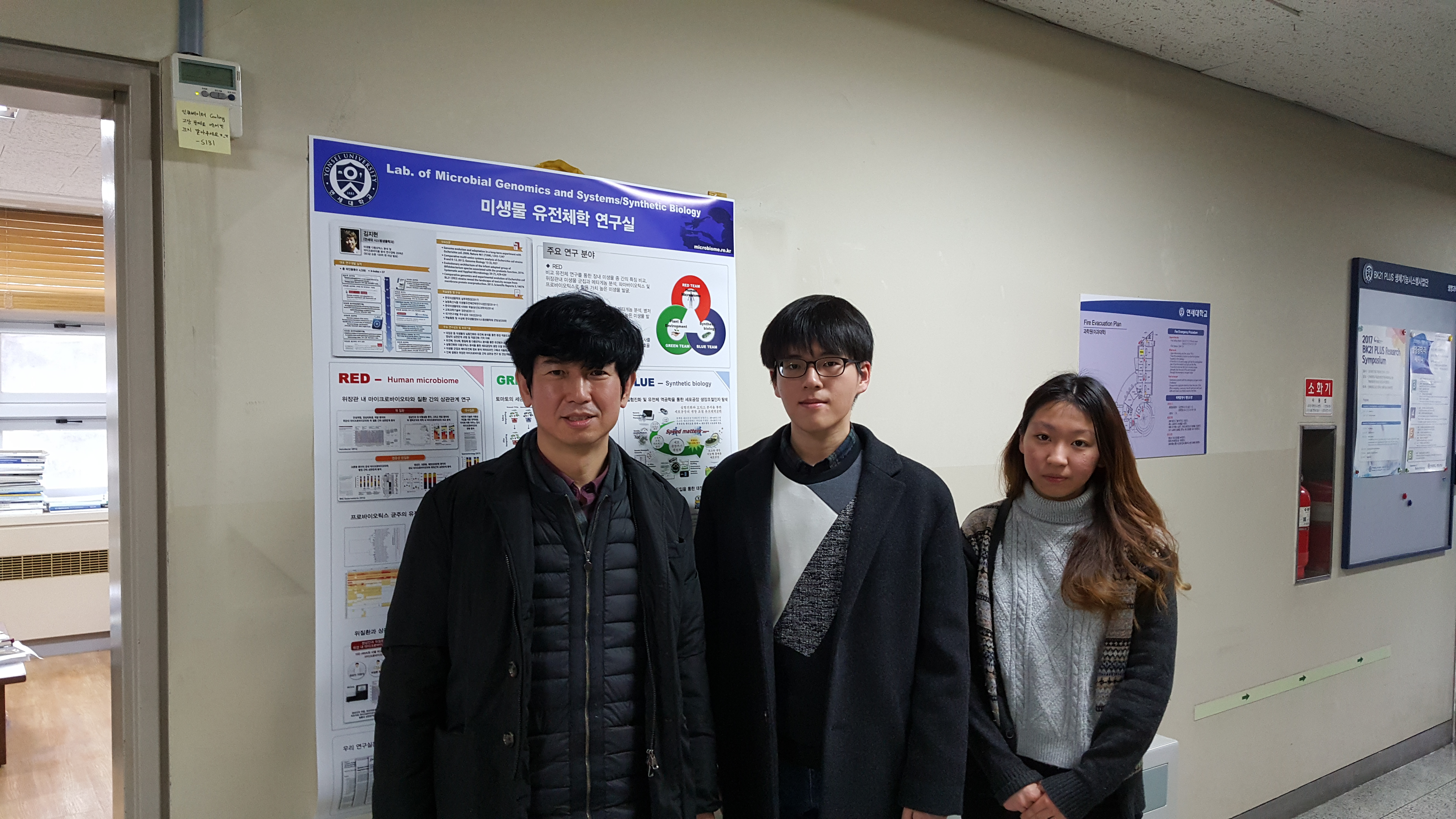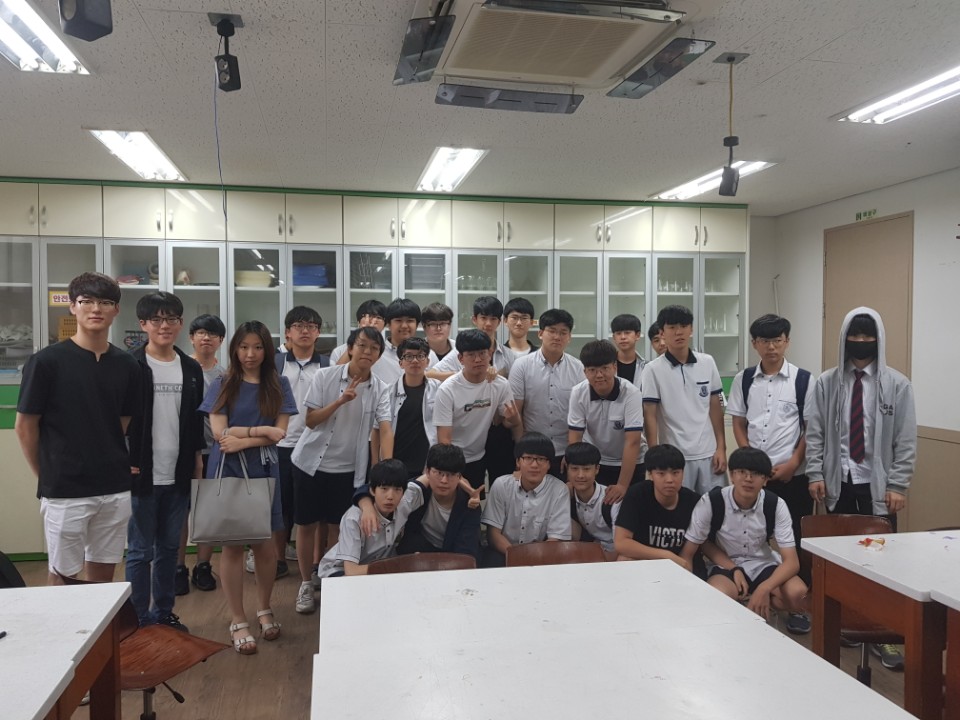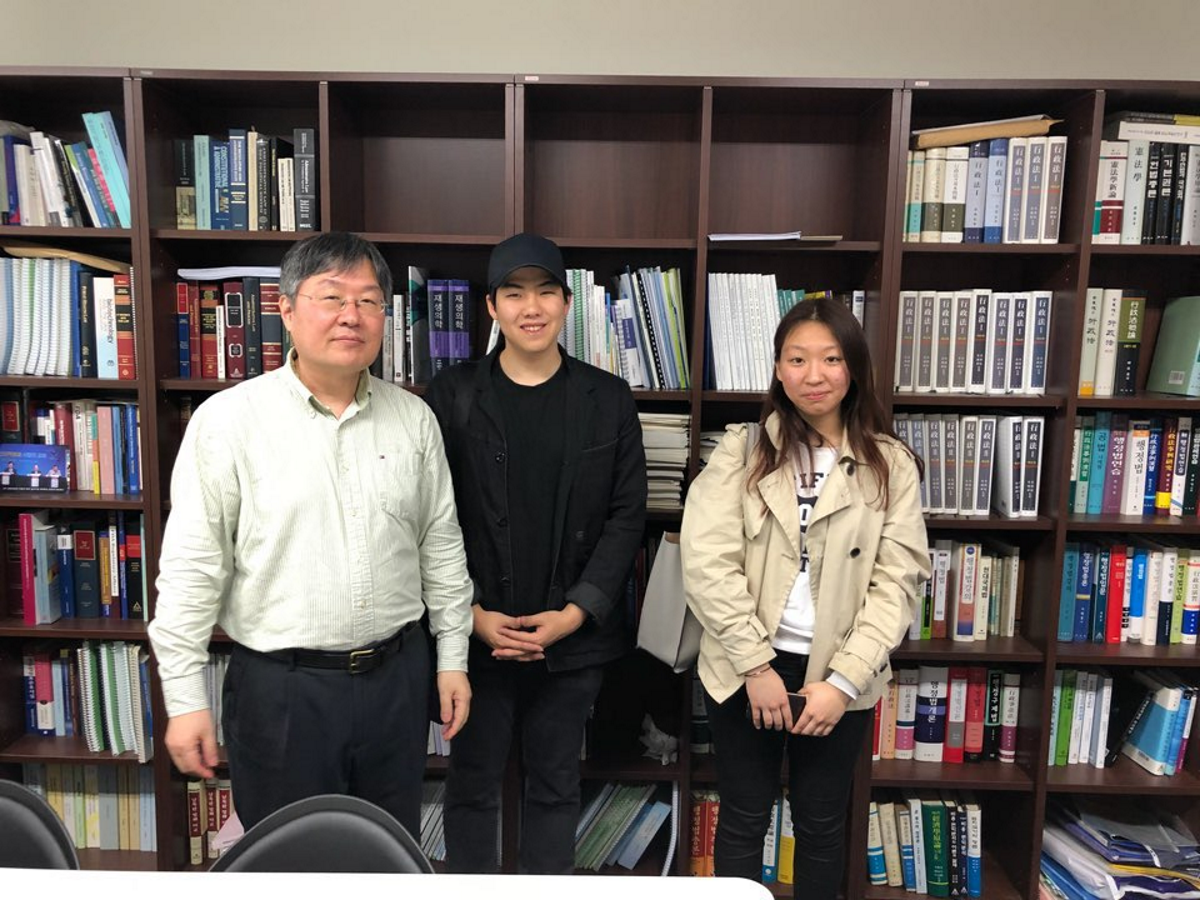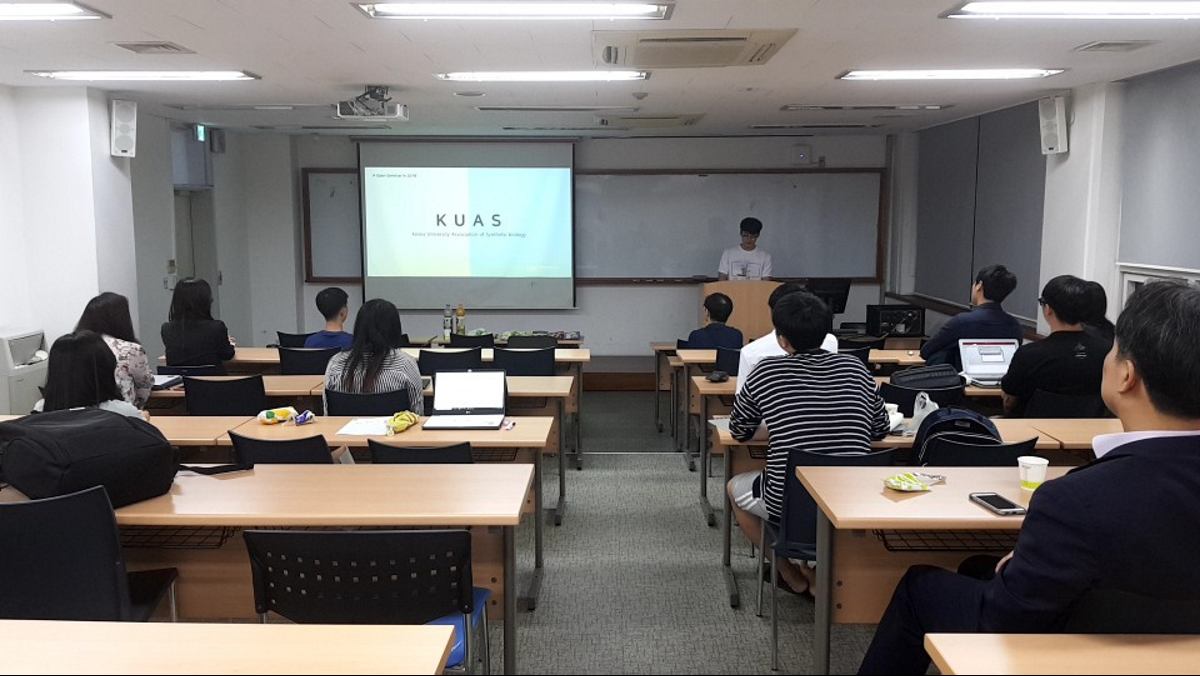Public Engagement |
Figuring out the current status of Synthetic Biology in Korea: Interview with a synthetic biologist

Our team visited one of the few synthetic biologists in South Korea, Professor Jihyun Kim of Yonsei university whose research focuses on the optimization of the system of organisms and the fine-tuning process. We requested an interview to Jihyu Kim because he was a synthetic biologist who meeted the reuirements of well-knowing the reality and status of Synthetic biology in Korea.
Throughout the interview, we discussed the history and the realistic prospect of synthetic biology. We first talked over the birth of synthetic biology and how the actual word “Synthetic biology” was born. We also compared the benefits and disadvantages of utilizing synthetic biology with chemical or physical methods in problem resolvation. The biggest difference is the direction of approach and the ability to easily synthesize macromolecules. Unlike small molecules, macromolecules are hard to build in a chemical way, and as the length gets longer the error rate increases exponentially. However, using organisms and designed synthetic biology methods solves the problem and at a considerable cost.
Furthermore, as a synthetic biologist, we pointed out the reality synthetic biology having low recognition to the public in Korea. We thought this atmosphere was formed by Korea’s education environment which only focuses on developing one’s major and directing attention away from other possible interests. To solve this problem, our team conducted an education session for Yeouido high school on introducing the general basis of Synthetic biology. Excessive competition in the academic field also removes the possibility of taking an attempt to a new field of science. We also considered the need of breakthrough in the synthetic biology field since we reached to an plateau resulting from our lack of knowledge of the organisms.
Moreover, the negative image of Gentic engineering displayed by the media also contributes to the avoidance of implementing this new branch of study. The interview led us to set our plans on changing out the recognition of Synthetic biology and Genetic engineering. We also felt the need to take a close look in the discomfort people are indicating about genetic engineering. The negative image imposed on GMOs and genetic engineering also made us acknowledge the current status of Synthetic biology in Korea and hold an open seminar for all undergraduate students.
High school education session in Yeouido highschool

As a part of the effort to popularize synthetic biology, we arranged a mentoring/lecture session for high school students interested in biology and considering it as their future major. We mainly focused on introducing the concepts of synthetic biology and showing how they are applied in real-life situations.
Synthetic biology is not yet a widely recognized field in Korea, and not many students hear of it in high school. This is problematic, since high school years play a vital role in investigating and deciding one’s own majors and careers. Therefore, we wanted to give these students a chance to learn about yet another aspect of biology, and share some first-hand experience as to how this field actually is from a researcher’s point of view. This way they will have some solid bases of facts and experiences on which they can decide their future, reducing trial and errors many students are going through.
The session was held in Yeouido high school, a science-priority school. Many of the participants were members of the biology club, although other students interested in biology were also present.
The mentoring was mainly comprised of three parts. First, we had a brief introduction about our university and team to the students. Next, we followed up with the definition and various techniques of synthetic biology, along with some actual examples of the studies. Finally, we had an exercise on using KEGG and the RSBP to search for parts to build their own synthetic organisms from. We received questions during the session, and between each successive part of the lecture.
During introduction, we explained the four departments in the college of life sciences & biotechnology, and how they differ from each other. We then talked about iGEM and our team’s activities related to it. We went over some of our previous projects, the Giant Jamboree and other efforts at studying and promoting synthetic biology.
In explaining the concepts of synthetic biology, we started off with the scientific backgrounds that led to the establishment of the field and explained its progress in diachronically. Next, we introduced the concept of Biobricks, and the meaning it has in formulating scientists’ point of view in biology. We then showed some basic assembly methods in synthetic biology, and how this can be used to ‘build’ organisms using biobricks.
We then went over some actual studies in synthetic biology, which includes PROP-Z, recombinant luminescent bacteria and efficient biofuel production. There were students in the lower grades present, and some of them seemed to have trouble keeping up during this part, so we tried to simplify the details, focus on key concepts and use metaphors to help them understand. This seemed to help, but we still received numerous questions during and after this part.
Exercise session began with each student setting an objective, such as a heat-sensing bacterial thermometer or edible antibiotics. We then explained how to use KEGG (Kyoto Encyclopedia of Genes and Genomes) and did a pathway-searching exercise with some simple metabolites. After that, we showed them the RSBP (Registry of Standard Biological Parts) that iGEM supports, and encouraged students to look for genes that are needed for their synthetic organisms. Both exercises were done via smartphones, and although their small screens proved somewhat of a problem when reading pathways and so on, they worked surprisingly well, and the students were quick and eager to catch up. However, some were disappointed at the limited choices on the current part list, which led to a discussion on the future of synthetic biology and its visions.
There was a Q&A session between each part of the mentoring, and the students had quite a number of questions. Many were about our high school days, and our studies in college. But others were about synthetic biology, such as the differences between synthetic biology and genetic engineering. A lot of students were also interested in iGEM, and were impressed by college undergraduates and even high school students participating in actual research projects.
Overall, this session was a valuable opportunity for not only the high school students but also for us, too. The students got to learn about the unknown but prominent field of synthetic biology, and hear about the everyday life of a science lab. We were able to see how little ordinary students knew about synthetic biology, and improve our educational methods and material. Although synthetic biology still has a long way to go, it is bound to reach its goal someday.
Legislations and ethics of GMM and synthetic Biology in Korea
Meeting with the Vice Minister of the Korea National Institute for Bioethics Policy(KoNIBP)

Our team has engaged direct stakeholder in order to hold a discussion on the ethical and legal limitations of synthetic biology and genetic engineering of microorganisms in Korea. In order to reach for an expert on bio legislations, we contacted the vice minister of the Korea National Institute for Bioethics policy (KoNIBP) and conducted an in-depth interview. Soo hun Park whom we contacted, teaches in the college of Law in Sookmyung Women’s University and is also the education committee member of The Korean Association of Institutional review boards. He is one of the most informed specialist on the field of bioregulations and ethical concerns of developing biotechnologies in Korea.
The interview questions were mainly dealing with current bio legislations of Korea and ethical laws that cope with upcoming technologies in the field of biotechnology. As Bioethics and Safety Act(생명 윤리 및 안전에 관한 법률) stand at present, we discussed the highly limited circumstances which we could apply gene therapy and the newly introduced crisper technologies in genetic engineering of humans. Due to the article 36 of the act, these therapies are forbidden in fetus or germline cells in Korea while in the UK these experiments were authorized by the law. Drawing comparisons of bioethics laws in different countries led us to conclude that genetic engineering in Korea is especially under strict regulations and also negatively portrayed by the media. The ministry of health and welfare claimed that they would lift the regulations in 2015 but there were no significant acts of amendment yet. From the interview, he mentioned the guideline of new direction; the ethics of synthetic biology and emerging technology, which is a risk-based approach on new technologies such as synthetic biology. He noted the fact that unlike the US there are no guideline in Korea but only restrictions. In addition, he explained the process of how the KoNIBP committee makes a decision on updated agendas related with conflict between ethics and technology. Furthermore, we inquired about the genetically modified microorganisms(GMM) and what regulations were they restricted by after being consumed by humans. Only the GMMs that are intake by human or human derivative materials are controlled by this bioethics and safety act.
The interview helped us get a grip of the current technology and ethical challenges they pose. This helped our team analyze the reasonableness and rationality of the current legislation of bioengineering and synthetic biology in Korea. Although this interview covered genetic engineering techniques related with human on a limited basis, this field is the actual hot spot of conflicts and ethical debates. Our team indicated that further discussion should be held in public to bring up the resolving solution that may lead to rational atonement.
Open seminar

One of the purposes of synthetic biology is to interact with the public and make an effort to think of the solution for social problem in these days. In order to accomplish the objective, we tried to provide a chance to the public to be familiar with synthetic biology, although the field is promising that as technology develops, awareness is relatively very low even to the bio-undergraduates. This year we had an open seminar targeting undergraduates in Korea regardless of majors. Throughout the seminar, we looked over from its history to applied cases to help participants deeply understand synthetic biology.
At the beginning, we illustrated the concepts of synthetic biology. First, we explained the idea of standardization and modularization, the most important and fundamental concepts of synthetic biology. The explanation of synthetic biology is followed by a presentation about iGEM competition. To help participants understand this area, the history of genetic engineering and synthetic biology and some examples of its study results were briefly descripted. After the introduction, we had illustrated some detailed parts of synthetic biology; diagnostics and environment part.
In diagnostics, we discussed detecting method for screening toxicity using synthetic biology regardless of the kind of toxins. In the aspects of disease control, early diagnosis is vital issue for the field of the preservation of health because invention of easier and cheaper diagnosis methods enables official health services to prevent and reduce deaths from certain diseases before patients suffer for deteriorated pains. To improve this area, synthetic biologists made microbeads containing different sorts of recombinant luminescent bacterium, which express unique luminescence when each of the bacterium detects specific toxins. This method has huge advantage in a respect of having the capacity to test whether someone has several diseases at the same time. Moreover, it can be used for other area like examination of water. This relates with the environmental application part.
In environment, synthetic biology was applied to making biofuels, sensing pollutants, and refining contamination. Biofuel is renewable energy (such as ethanol, diesel oil etc.) produced by using eco-friendly biomass such as sugarcanes, CAM plant, whey and even waste sulfite liquors. The process of manufacturing biofuels goes on by culturing recombinant strains like yeast with these biomasses. And the recombinant microbes can be used not only for prevention and detection of a pollution, but for purification of polluted spaces by a series of designed mechanisms which metabolizes pollutants to another harmless substances.
Last but not least, we suggested the outlook of synthetic biology in a developmental and ethical aspects. The way to develop synthetic biology can be told it is on an extension of its history so far. The direction of synthetic biology is on the two points; decentralization and convergence. Decentralization is shown through the effort to distribute the authorities of bioscientists. The increases of RSBP(Registry of Standard Biobrick Part), SBOL(Synthetic Biology Open Language) and DIYbio are all the present-progressing consequences. Meanwhile, setting up of many synbio communities (such as GENSPACE, bioCURIOUS and LA PAILLASSE) let all the synthetic biological studies collected, integrated and arranged easily. The development of this field is important because biology has a lot of possibility to be combined with other field such as space science. However, it is inevitable that current aggregates of the researches also have some shortages. The basic problem is attributed to the properties of synthetic biology that it uses very sophisticate stuffs and methods for study. This property causes an incompleteness and uncertainty of all registries. These prospects and challenges are the tasks facing us.
Throughout sessions, participants got an opportunity to encounter a new sector of biology and broaden the knowledge of synthetic biology. Progressing the seminar, they were inspired to this area and showed an interest in iGEM competition and our academy. There were even students from other majors that are not related to biology. Feedback was generally good in that the field was new for them, thus interesting and discussed subjects were somehow related to their lives
Sponsors




